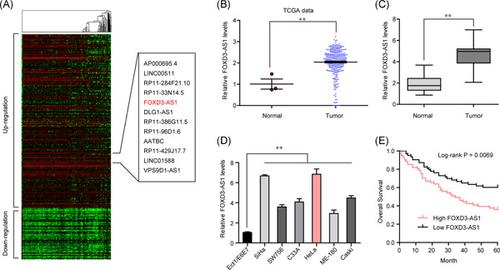当前位置:
X-MOL 学术
›
J. Cell. Biochem.
›
论文详情
Our official English website, www.x-mol.net, welcomes your feedback! (Note: you will need to create a separate account there.)
SP1-induced lncRNA FOXD3-AS1 contributes to tumorigenesis of cervical cancer by modulating the miR-296-5p/HMGA1 pathway.
Journal of Cellular Biochemistry ( IF 4 ) Pub Date : 2020-09-22 , DOI: 10.1002/jcb.29846 Wen-Guang Ma 1 , Si-Mao Shi 1 , Lu Chen 1 , Ge Lou 2 , Xiao-Ling Feng 1
Journal of Cellular Biochemistry ( IF 4 ) Pub Date : 2020-09-22 , DOI: 10.1002/jcb.29846 Wen-Guang Ma 1 , Si-Mao Shi 1 , Lu Chen 1 , Ge Lou 2 , Xiao-Ling Feng 1
Affiliation

|
Long noncoding RNAs (lncRNAs) have drawn growing attention due to their regulatory roles in various diseases, including tumors. Recently, lncRNA FOXD3 antisense RNA 1 (FOXD3‐AS1) was shown to be overexpressed in colon adenocarcinoma and glioma, exerting oncogenic functions. However, its expression and effects in cervical cancer (CC) remained unknown. In this research, our group first reported that the levels of FOXD3‐AS1 were distinctly elevated in CC samples and cell lines. The distinct upregulation of FOXD3‐AS1 was associated with lymphatic invasion, distant metastasis, and International Federation of Gynecology and Obstetrics stage, and also predicted poor clinical results of CC patients. Next, transcription factor SP1 was demonstrated to resulting in the upregulation of FOXD3‐AS1 in CC. Functional assays indicated that knockdown of FOXD3‐AS1 distinctly suppressed CC progression via affecting cell proliferation, cell apoptosis, and metastasis. Moreover, mechanistic studies suggested that FOXD3‐AS1 acted as an endogenous sponge by directly binding miR‐296‐5p, resulting in the suppression of miR‐296‐5p. In addition, we also reported that high mobility group A, a direct target of miR‐296‐5p, could mediate the tumor‐promotive effects that FOXD3‐AS1 displayed. Overall, our present study might help to lead a better understanding of the pathogenesis of CC, provide a novel possible tumor biomarker, and probe the feasibility of lncRNA‐directed treatments for CC.
中文翻译:

SP1 诱导的 lncRNA FOXD3-AS1 通过调节 miR-296-5p/HMGA1 通路促进宫颈癌的肿瘤发生。
长链非编码 RNA (lncRNA) 因其在包括肿瘤在内的各种疾病中的调节作用而受到越来越多的关注。最近,lncRNA FOXD3反义RNA 1(FOXD3-AS1)被证明在结肠腺癌和神经胶质瘤中过度表达,发挥致癌作用。然而,其在宫颈癌(CC)中的表达和影响仍然未知。在这项研究中,我们小组首先报道了 CC 样品和细胞系中 FOXD3-AS1 的水平明显升高。FOXD3-AS1 的明显上调与淋巴浸润、远处转移和国际妇产科联合会分期有关,也预测了 CC 患者的不良临床结果。接下来,转录因子 SP1 被证明会导致 CC 中 FOXD3-AS1 的上调。功能分析表明,敲除 FOXD3-AS1 通过影响细胞增殖、细胞凋亡和转移明显抑制 CC 进展。此外,机制研究表明 FOXD3-AS1 通过直接结合 miR-296-5p 充当内源性海绵,从而抑制 miR-296-5p。此外,我们还报道了 miR-296-5p 的直接靶标高迁移率组 A 可以介导 FOXD3-AS1 显示的肿瘤促进作用。总体而言,我们目前的研究可能有助于更好地了解 CC 的发病机制,提供一种新的可能的肿瘤生物标志物,并探讨 lncRNA 指导治疗 CC 的可行性。机制研究表明 FOXD3-AS1 通过直接结合 miR-296-5p 充当内源性海绵,从而抑制 miR-296-5p。此外,我们还报道了 miR-296-5p 的直接靶标高迁移率组 A 可以介导 FOXD3-AS1 显示的肿瘤促进作用。总体而言,我们目前的研究可能有助于更好地了解 CC 的发病机制,提供一种新的可能的肿瘤生物标志物,并探讨 lncRNA 指导治疗 CC 的可行性。机制研究表明 FOXD3-AS1 通过直接结合 miR-296-5p 充当内源性海绵,从而抑制 miR-296-5p。此外,我们还报道了 miR-296-5p 的直接靶标高迁移率组 A 可以介导 FOXD3-AS1 显示的肿瘤促进作用。总体而言,我们目前的研究可能有助于更好地了解 CC 的发病机制,提供一种新的可能的肿瘤生物标志物,并探讨 lncRNA 指导治疗 CC 的可行性。
更新日期:2020-09-22
中文翻译:

SP1 诱导的 lncRNA FOXD3-AS1 通过调节 miR-296-5p/HMGA1 通路促进宫颈癌的肿瘤发生。
长链非编码 RNA (lncRNA) 因其在包括肿瘤在内的各种疾病中的调节作用而受到越来越多的关注。最近,lncRNA FOXD3反义RNA 1(FOXD3-AS1)被证明在结肠腺癌和神经胶质瘤中过度表达,发挥致癌作用。然而,其在宫颈癌(CC)中的表达和影响仍然未知。在这项研究中,我们小组首先报道了 CC 样品和细胞系中 FOXD3-AS1 的水平明显升高。FOXD3-AS1 的明显上调与淋巴浸润、远处转移和国际妇产科联合会分期有关,也预测了 CC 患者的不良临床结果。接下来,转录因子 SP1 被证明会导致 CC 中 FOXD3-AS1 的上调。功能分析表明,敲除 FOXD3-AS1 通过影响细胞增殖、细胞凋亡和转移明显抑制 CC 进展。此外,机制研究表明 FOXD3-AS1 通过直接结合 miR-296-5p 充当内源性海绵,从而抑制 miR-296-5p。此外,我们还报道了 miR-296-5p 的直接靶标高迁移率组 A 可以介导 FOXD3-AS1 显示的肿瘤促进作用。总体而言,我们目前的研究可能有助于更好地了解 CC 的发病机制,提供一种新的可能的肿瘤生物标志物,并探讨 lncRNA 指导治疗 CC 的可行性。机制研究表明 FOXD3-AS1 通过直接结合 miR-296-5p 充当内源性海绵,从而抑制 miR-296-5p。此外,我们还报道了 miR-296-5p 的直接靶标高迁移率组 A 可以介导 FOXD3-AS1 显示的肿瘤促进作用。总体而言,我们目前的研究可能有助于更好地了解 CC 的发病机制,提供一种新的可能的肿瘤生物标志物,并探讨 lncRNA 指导治疗 CC 的可行性。机制研究表明 FOXD3-AS1 通过直接结合 miR-296-5p 充当内源性海绵,从而抑制 miR-296-5p。此外,我们还报道了 miR-296-5p 的直接靶标高迁移率组 A 可以介导 FOXD3-AS1 显示的肿瘤促进作用。总体而言,我们目前的研究可能有助于更好地了解 CC 的发病机制,提供一种新的可能的肿瘤生物标志物,并探讨 lncRNA 指导治疗 CC 的可行性。



























 京公网安备 11010802027423号
京公网安备 11010802027423号